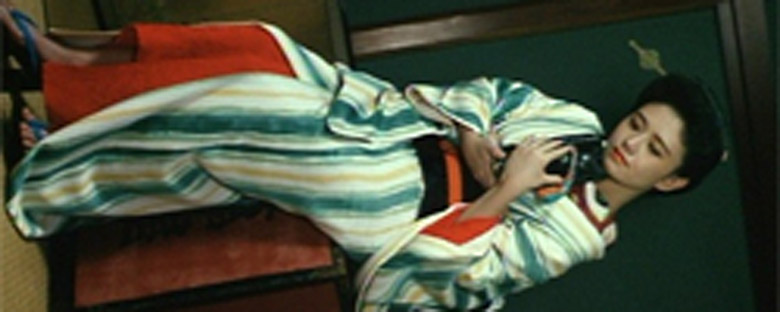Reviews
Seijun Suzuki
Japan, 1991
Credits
Review by Ian Johnston
Posted on 06 June 2006
Source Kino Video DVD
Related articles
Features: Seijun Suzuki’s Taisho Trilogy
Reviews: Branded to Kill
Reviews: Fighting Elegy
Reviews: Kagero-za
Reviews: Youth of the Beast
Reviews: Zigeunerweisen
If you’ve got as far as Yumeji, the third of Seijun Suzuki’s Taisho Trilogy, you’ll be in no doubt that the ostensible subject of the film, the real-life painter and poet Takehisa Yumeji (1884-1934), will hardly lead to a conventional biopic; and you’ll be absolutely right. Take the film’s opening: Large, brightly-coloured balls thrown up into the sky by a group of men and women in Western dress. Yumeji pushing through them in Japanese dress. A woman in a kimono hovering suspended in a tree. A bizarre pistol duel where Yumeji is shot, then is revived as he is told he can’t be dead. A fractured narrative, where Yumeji is on his way to Kanazawa to “elope” (that’s what the subtitles say) with Hikono but is diverted by an encounter with a lower-class woman (a prostitute). Close-ups of his hand on a wooden beam that dissolve into paintings. A medium-shot of her on a travel trunk, on which a painting likewise appears and fades away.
In this moody, dreamlike, impressionistic way — disjointed by sudden jarring bursts of black humour and slapstick — Yumeji’s twin obsessions with art and women are quickly sketched. And after this initial flurry of confusing images and abrupt shifts in tone, Yumeji settles down, with the appearance of Hikono, to more of a semblance of a clearly advancing narrative. At Kanazawa Yumeji bides his time, waiting for Hikono to arrive, and his attentions turn to the beautiful Tomoyo, widow of the recently slain Wakiya. Not that this set up is initially ever made clear, with Yumeji and Tomoyo’s “meeting cute” being conveyed through a series of obscure shots: Tomoyo’s bright-yellow boat surging across the dark green light, then plunging into a spread of bright red flowers, and suddenly rising up vertically as Yumeji himself rises up out of the water…
But even the progress of Yumeji and Tomoyo’s affair is conveyed to us in fits and starts, with Tomoyo demure and chaste in one brief scene/shot and libidinous in the next, and Yumeji’s interest in her likewise shifts and jolts, from groping “masher” (ladykiller) to aesthete/artist. There’s no single point where we can get a fix on a character.
Things don’t become any clearer as the plot thickens with the appearance of the scythe-swinging bandit Matsu (an Id-figure to parallel those of Zigeunerweisen’s Nakasogo and Kagero-za’s anarchist), the addition of the artist’s model Oyo as the third of the women Yumeji’s interested in, the introduction of Yumeji’s artist-rival Gyoshu Inamura, and the rather confusing return of Matsu’s victim, Tomoyo’s slain husband Wakiya. In any other film, you could treat Wakiya’s return as the apparition in the centre of a ghost story, but it hardly seems apposite to talk of Yumeji as a ghost story when every character and every scene partakes of a similar dreamlike, logic-bending mood.
Originally, Suzuki never had any plans for the trilogy of films that we now have. Zigeunerweisen and Kagero-za were devised as companion pieces, but Yumeji is more of an addendum, after a ten-year gap, to those earlier films. It stands apart, with Yumeji’s artistic world having far less to do with the Westernised social and cultural world of the Taisho era that we get in Zigeunerweisen and Kagero-za. In addition, the aesthetic look of the film is very different. There is a very aestheticised use made of the appearance of the traditional Japanese interior, the way screens and dividing walls create flat surfaces bound by horizontal and vertical lines and the way the layout of the traditional Japanese house creates different blocks of space (some empty, some filled) receding from the foreground to the background.
Japanese art is the source for the visual look of the film and is its subject. The confusing twisting-and-turning, back-and-forth tone of Yumeji’s dream narrative is as attenuated, as drawn-out, and, frankly, as tiring as those of Zigeunerweisen and Kagero-za. Whether Yumeji’s final scene was inspired by the sublime closing sequence of Andrei Rublev, the effect is the same, even if it’s not quite as elevated. Standing in a field of tall grasses Yumeji asks himself “For whom was I waiting? For what was I waiting?” and is answered by the film’s final few moments: a return to the woman floating in the tree from the opening sequence, except this scene now segues into the culmination of everything—Yumeji’s painting “Song of Evening Primrose”, which the camera first explores in close-up and then slowly pulls back from, retreating further and further back until the painted screen is left hovering in the centre of the image, surrounded by black. Of all the Taisho Trilogy films, it makes for the most satisfying of endings. It’s just a pity that the journey to reach this point too often loses our interest along the way.
We don’t do comments anymore, but you may contact us here or find us on Twitter or Facebook.



